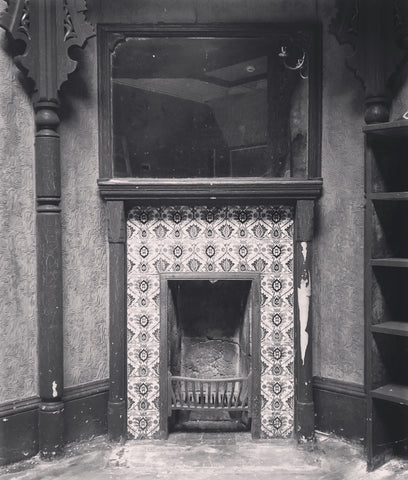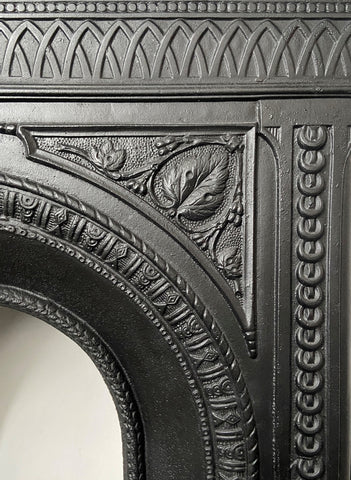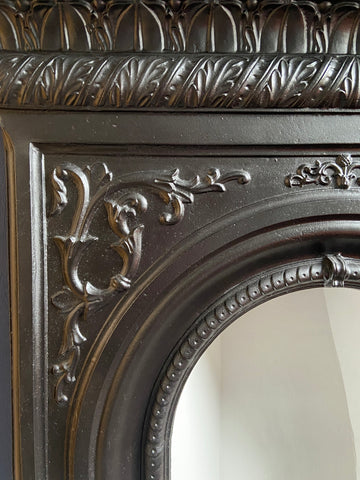There's no Smoke Without Fire & Fireplaces
For tens of thousands of years ever since human kind first learned to control fire we’ve had a love affair with living flame. But in reality it’s only until relatively recently that we’ve utilised fireplaces for other purposes other than just our primary source of heating and cooking. The design innovations we see today are as a direct result of the pioneering work carried out in the Stuart, the Georgian, and Victorian periods. Ever since then the use of fire in our homes has largely been about the creation of stylish focal points that in essence are there primarily to make a statement.
The Stone Age:
The discovery of fire by our ancient predecessors was arguably a pivotal point in human history, in that the ability to be able to start and control fire played has without doubt played a significant role in the development of our society.
Humankinds first use of something akin to a firepit is thought to have occurred around 400,000 years ago during the Palaeolithic or Old Stone Age. Archaeological evidence of regular fire pit use found in Southern Africa and the Middle East shows that pits made of a collection of stones designed to contain the fire and prevent it from spreading were in regular use, providing heat, light and the wherewithal to cook foods as well as ward off predators.
The Bronze Age & Iron Age:
Archelogy reveals humans began using flints to ignite combustible materials to start fires around 40,000 years ago, some 8000 years ago humans began the process of smelting lead and tin, this was quickly followed by copper about 5000 years ago and then iron about 4000 years ago. The two more recent metal formats required the use of a kiln arrangement of some form, and we know this because a simple open firepit wouldn’t get much above 200°C. So this is really the turning point when human kind began to get to grips with fire and develop fire management technology. This development saw the introduction and regular use of fixed indoor hearths by the Ancient Greeks around 4500 years ago.
The European Celts followed suit, introducing indoor fire pits to their round houses during the Iron Age, from about 500BC until 800AD. Though in most cases this essentially was nothing more than a ring of stones in the centre of the building onto which combustible materials were placed and burnt, above which was a small hole in the roof to let smoke out.
The Romans upped the ante quite a bit around 2300 years ago, introducing portable hearths, which were a significant advancement in fireplace technology, and essentially meant fire could be safely contained and transported from location to location if required. That all went by the wayside though with the fall of the Roman Empire as Europeans slowly reverted to the old ways as technological know-how diminished preferring to use centrally located firepits for cooking and heating in their buildings.
The Normans:
The introduction of stone buildings by the Normans in the 11th century literally open the door to new fireplace technology; firepits were replaced with fireplaces, which were placed on outside walls with short chimneys above also made of stone to allow the smoke out of the room.
This advancement also meant that a fireplace could be placed in each room and even in rooms above the ground floor, though still really the preserve of the wealthy. Fireplace technology continued to develop and by the 14th century the chimney had become a status symbol, so much so that hearth taxes were levied in England by the Crown for some considerable time under various guises… hearth money, chimney tax, or chimney money until the tax was repealed by an act of Parliament in 1689.
The Stuarts & the English Civil War:
1678 saw the invention of the fireplace grate by Prince Rupert of the Rhine, King Charles I’s nephew, who aside from being rather good at commanding cavalry was also something of an inventor. He discovered that by elevating the frame used for holding combustible materials provided for much better air circulation both from underneath and the sides, which essentially increased the heat output significantly and the overall efficiency of the fire – unsurprisingly this simple but cost-effective design took off very quickly.

The Georgian:
With advancements in metal technology cast iron fireplaces had become all the rage, especially during the Georgian and Regency periods from the reign of King George I to George IV. Fireplaces from this period were characterised by their iron register grates, open baskets with simple marble surrounds with bulls-eyes, reeded panels or keystone details.
In essence Fireplaces had become the focus of room design; they were grand statement pieces and were often built to grandiose proportions and handily the invention of the Pennsylvania Fireplace by Benjamin Franklin in 1742 meant that these rather large statement fireplaces could be used efficiently.
Inspired by the work of Franz Kessler and Jean Desaguliers, Franklin worked to create a device that would increase burn time in order to get more heat from fewer logs, which with a significant wood shortage was quite significant. Inspired by Franz Kessler’s earlier work on an inverted siphon in the early 1600s Franklin created a u-shaped cast iron box to act as a duct between the fireplace and chimney, which her called an ‘aerial syphon,’ designed to reflect as much heat as possible into the room and send the by-products up the chimney. Essentially he’d created a precursor to the modern fireplace insert, which he shoes to make using cast iron inspired by the findings of Jean Desaguliers, who had discovered that as a material cast iron was far better at radiating heat into a room compared to traditional open fireplaces made of brick or stone.
Rapidly following on from this this, Sir Benjamin Thompson or as was also known Count Rumford, designed a fireplace in 1796, which incorporated a tall, shallow firebox. Thompson introduced the idea of restricting the chimney opening to increase the pull, he modified fireplaces by inserting bricks into the hearth to angle the side walls, and he also added a choke to the chimney to increase the speed of the airflow going up the flue. These two actions enable the regulation of airflow which also provided more control in relation to the rate at which fuel was burnt revolutionising chimney design.

The Victorians:
Queen Victoria came to the throne in 1837 and ruled continuously until 1901, which is why perhaps much of the housing stock built during that period is still very much in evidence up and down the British Isles. There were two main types of fireplace in use during the Victorian period, early and mid-Victorian era fireplaces were often very ornate and floral in design and these castings continue to be popular to this day. The late Victorian period saw the introduction of simplified designs with emphasis on geometric shapes and patterns, with a wide variety of materials in use either for the fireplace itself or the surround or mantel associated with it, including, stone, marble, cast iron and wood. Whilst fireplace tiles used within the castings tended to reflect the shift in interior design tastes. Both styles are once more very popular, with many homes containing either style, and in many cases as the main focal point within the principle room I the property. This in reality stems from people seeking to authentically restore their homes, adding character to period properties which is appropriate to the period of the home in question.
Art Nouveau:
The Art Nouveau period is an important step in the evolution of design and is perceived as the ‘bridge’ between the earlier Neo-classical style and the Modernist styles that followed. The era spanned a relatively short period of time, yet was very energetic and swept round the world from perhaps the early 1880’s through to 1914, with its greatest popularity spanning the 1890’s to 1905. The design motifs established by this movement found their way into the design of key interior features, not least the fireplaces that still grace the homes built during this period. Designs became more dramatic often featuring organic elements, such as stylised flowers and swooping, swirling vines. As well as these natural flourishes, Art Nouveau fireplaces tended to accentuate geometric shapes and vertical lines, characteristics included swirling lines, delicate tendrils, exotic figures and elaborate geometry.

Arts & Crafts:
The Arts and Crafts Movement first emerged in 1861, ten years after The Great Exhibition of 1851 held at Crystal Palace, London. Its main advocates, John Ruskin, William Morris, and Pugin, were appalled with the industrialisation of design and they longed to see a return to natural forms.
Beginning in around 1880, this design aesthetic rapidly grew in popularity across Europe and America until around 1920. Developed as a response to industrialisation and mass manufacturing the movement championed traditional craftsmanship to craft elegant designs.
It’s style is easily recognised from the use of geometric patterns, simple forms, such as medieval and folk-inspired decoration from newly discovered Aztec and Mayan civilisations and romanticised Native American art forms.
As a result, many Arts & Crafts fireplaces were handcrafted, and, like the Art Nouveau fireplaces that came after them, were influenced by natural forms. They featured a variety of different materials, including brick, stone, cast iron, terracotta, tile and even concrete, essentially anything that wouldn’t burn.
Edwardian:
The Edwardian period overlapped with that of the Art Nouveau, roughly spanning the period between 1900 and 1920. Fireplaces of the period, where characterised by their simple design and sparse detailing, tiled fireplaces were often constructed using only a single colour, and occasionally large-tile panels with the addition of a canopy on legs. In some ways, the design aesthetic was very similar to that of the late Victorian period with simple yet elegant designs. Edwardian fireplaces were generally made from cast iron, which as design tastes changed became slimmer and taller in stature, and in many cases as previously mentioned featured a single-coloured tiles as the main feature. Towards the end of the period tiled cast iron inserts were being gradually superseded by essentially canopies on legs. These structures incorporated large, angled panels on either side of the fireplace, which covered the space between canopy and the surround.
Art Deco:
Characterised by sharp lines and bold geometric shapes which originated in France in the early 1910’s and became popular in England after WWI and was the height of fashion during the 1920s and 1930s, continuing until the 1960’s. Indeed it was probably one of the most influential design periods in history.
Towards the end of the period with the arrival of mass manufacturing techniques and the increasing use of new materials such as stainless steel and chrome these fireplaces became more affordable to more sectors of society. These materials suggested that the modern, mechanised world had arrived and as a result was firmly embraced in design terms. Indeed a great number of the fireplaces of the time made use of these sleek, reflective materials, often combining them with lacquered woods to create truly striking pieces. Pieces were characterised the celebration of the modern, influenced by the bold colours of Fauvism, the geometric shapes of Cubism and design elements taken from Egypt, Persia, Japan and China.
This was the modern age and mass manufacturing meant that these plentiful and cheap materials could be harnessed to great effect, which in turn meant that fireplaces made using mechanised means were more affordable and therefore more accessible to a broader range of the population.

Modernism
Following the end of World War II there was a new found optimism, consumerism was in full swing due to a new found prosperity and life in general was much easier than it ever had been. Consumer demand had changed significantly, and people wanted products that were interchangeable, inexpensive and easily replaceable. As a result universal designs were being created to meet the demand, which in turn made it easier and much more affordable to buy products and then should people wish dispose of them, and this was also true of fireplace design.
With designs utilising two main design formats built-in and freestanding. Built-ins were usually installed into the wall surrounded by either brick or stone, though the freestanding version usually has a slimline chimney and arched opening.
The movement’s aesthetic is characterised by simplicity in form and function, making use of clean, unadorned lines, bold colours, geometric shapes and repetition. The period is known for its forward-thinking designs, incorporating a wide variety of materials, including porcelain, steel, brick, concrete, aluminium and glass underpinned by the use of new technology and sleek contemporary design inspired by events such as the launch of the Sputnik satellite.
Post-Modernism:
From the 1970’s to the present-day postmodernism has become something of an antidote to Modernism and the perceived blandness of the designs they incorporate, utilising a wide array of materials, including ledgestone (thin slices of engineered stone in varying lengths), concrete, slab (a whole piece of stone with an opening cut into if for the fire grate), fieldstone (reclaimed stones that look like they’ve been recently dug up), and steel as well as more common materials such as brick and wood. After years of moving away from ornamentation, it has now started to be reintroduced and fireplaces are once more, and rightly so statement pieces within rooms.
We have an extensive collection of fireplaces, grates, fire surrounds, inserts, fire backs and fire places accessories to view our current stock visit: https://yewtreebarn.co.uk/collections/chimneypieces-fireplaces

Leave a comment